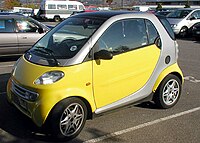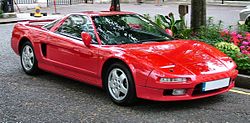Car classification
Car classification is a somewhat subjective subject, as many vehicles fall between classes or even outside all of them. Not all car types are sold in all countries and names differ in some cases between British and American English. The following are commonly used classifications. Where applicable, the relevant EuroNCAP classifications are shown.
| United States | EuroNCAP | Euro size | Example |
|---|---|---|---|
| Microcar | - | Microcar | Smart Fortwo |
| - | Supermini | A class | Fiat Panda |
| Subcompact | B class | Ford Fiesta | |
| Compact | Small family car | C class | Ford Focus |
| Mid-size | Large family car | D class | Volkswagen Passat |
| Full-size | E class | Chrysler 300 | |
| Luxury | Executive car | F class | Mercedes-Benz S-Class |
| Sports | - | Sports | Porsche 911 |
| Convertible | - | Cabriolet | BMW 3-Series |
| Roadster | Roadster | Roadster | BMW Z4 |
| - | Small MPV | MIni MPV | Opel Meriva |
| - | Compact MPV | Renault Scénic | |
| Minivan | MPV | Large MPV | Toyota Previa |
| Crossover SUV | Small Off-Roader | - | Honda CR-V |
| SUV | Large Off-Roader | - | Jeep Grand Cherokee |
Microcar
- Main article Microcar
- Main article Bubble car
Straddling the boundary between car and motorbike, these vehicles have engines of only a few hundred ccs, typically seat only 2 people, and are generally unorthodox in construction. Many only have three wheels. They are especially associated with post-war Europe, where their appearance led them to be called Bubble cars. A contrast to the traditional microcar is the modern Smart Fortwo.
Examples of microcars:
- CLEVER
- Daihatsu Copen
- Fend Flitzer
- Messerschmitt microcar
- Isetta
- Goggomobil
- Heinkel microcar
- Smart Fortwo
- Trojan (automobile)
Hatchback
- Main article Hatchback
City car
- Main article City car
A city car is a small car intended for use in urban areas. Unlike microcars, city car's greater speed and occupant protection allow relative safety in mixed traffic environments and in all weather conditions. While it may be capable of freeway speeds this is not the main purpose of the car.
In Japan, a specially restricted type of these (under 3.40m long) are called the keicar, where taxes and insurance are lower.
Examples of city cars:
- Daihatsu Mira
- Fiat Cinquecento
- Fiat Seicento
- Mazda Carol
- Mitsubishi Minica
- Peugeot 107
- Renault Twingo
- Suzuki Alto
Supermini / Subcompact car
- Main article Supermini car
- Main article Subcompact car
This class, known as superminis in Europe and subcompact cars in North America, covers the not-so-small hatchbacks and the smallest sedans. These vehicles are the smallest cars widely sold in the North American market. They have usually three, four or five doors and are designed to seat comfortably four adults and a child, but can take five adults. Current supermini hatchbacks are around 3.90m long and sedans 4.20m long.
In Europe, the first superminis were the Fiat 500 of 1957 and the Austin Mini of 1959. Today, superminis are some of the biggest selling cars in Europe.
Examples of superminis / subcompact cars:
- Austin Metro
- Austin Mini
- BMW MINI
- Citroën AX
- Fiat Punto
- Fiat Palio
- Fiat Uno
- Ford Fiesta
- Kia Rio
- Mercedes-Benz A-Class
- Nissan Micra/March
- Opel Corsa
- Peugeot 205
- Renault 5
- Renault Clio
- Rover Metro
- Volkswagen Polo
This category is equivalent to the EuroNCAP class 'Superminis'.
Small family car / Compact car
- Main article Family car
- Main article Compact car
Compact cars are usually referred to the longest hatchbacks or the smallest family cars. Nowadays they are about 4.25 m long, have room for five adults and their engines are usually around 1.6 L to 2.0 L.
Examples of hatchback small family cars / compact cars:
- Citroën Xsara
- Fiat Stilo
- Ford Escort
- Ford Focus
- Honda Civic
- Opel Astra
- Peugeot 306
- Peugeot 307
- Renault Mégane
- Toyota Corolla
- Volkswagen Golf
This category is equivalent to the EuroNCAP class 'Small Family Cars'.
Sedan/saloon and station wagon / estate
- Main article: Sedan (car) (aka saloon)
- Main article: Station wagon (aka estate)
Family car
- Main article Family car
Longer than hatchbacks, they have room for five adults and a larger boot, depending on the size. The most popular layouts are sedan/saloon and station wagon/estate. This class makes up the largest percentage of vehicles in most developed countries.
Examples of sedan/estate small family cars / compact cars:
This category is equivalent to the EuroNCAP class 'Small Family Cars'.
Examples of large family cars / mid-size cars:
- Alfa Romeo 159
- Alfa Romeo 166
- Fiat Croma
- Ford Taurus
- Ford Mondeo
- Honda Accord
- Nissan Primera
- Opel Vectra
- Peugeot 406
- Renault Laguna
- Toyota Camry
- Volvo S40
- Volkswagen Passat
- Dodge Charger
This category is equivalent to the EuroNCAP class 'Large Family Cars'.
Executive car / Luxury car
- Main article Luxury car
- Main article Executive car
An executive car or luxury car are typically four-door sedan/saloon cars. They are usually very roomy, powerful, and luxurious, which is a reason why they are more expensive than "standard" sedans.
Examples of executive cars / mid-size luxury cars:
Examples of full-size luxury cars:
- Audi A8
- BMW 7-Series
- Cadillac DeVille
- Jaguar XJ
- Holden Commodore
- Lancia Thesis
- Lexus LS
- Lincoln Town Car
- Mercedes-Benz S-Class
This category is equivalent to the EuroNCAP class 'Executive Cars'.
Sportive cars
Hot hatch / sport compact
- Main article Hot hatch
- Main article Sport compact
A hot hatch or sport compact is a high-performance hatchback based on standard superminis or small family cars, with improved straight line performance, handling and styling. Hot hatches make up a large section of the market for hatchbacks.
Examples of hot hatches:
- Ford Focus RS
- Ford Escort RS Cosworth
- Peugeot 205 GTI
- Renault 5 Turbo
- Renault Clio 182
- SEAT León Cupra R
- Vauxhall Astra VXR
- Volkswagen Golf GTI
Sports sedan / saloon
- Main article Sports sedan
These are high performance versions of sedans. Originally homologated for production based motorsports (touring cars) and like sedans, seats four people.
Examples of sports sedans / saloons:
- Alfa Brera
- BMW M3
- BMW M5
- Lotus Cortina
- Lotus Carlton
- Mitsubishi Lancer Evolution
- Nissan Skyline GT-R
- Subaru Impreza
- Chrysler 300C SRT-8
Sports car
- Main article Sports car
This small lightweight class combines performance and handling. Often inspired by racing vehicles. This class ranges from sporty vehicles such as the MX-5 to derivatives of true racing thoroughbreds such as the Lotus Elise.
Examples of sports cars:
- AC Cobra
- Austin-Healey 3000
- Caterham Super Seven
- Chevrolet Corvette
- Dodge Viper
- Honda S2000
- Jaguar E-type
- Lotus Elise
- Mazda Miata/MX-5
- MG MGB
- Porsche 911
- Toyota MR2
Grand tourer
- Main article Grand tourer
Larger, more powerful and heavier than sports cars, these vehicles typically have a FR layout and seating for four or 2+2. They are more expensive than sports cars but not than supercars, and often combine modern technology with hand-built construction.
Examples of grand tourers:
Supercar
- Main article Supercar
They are ultra-high performance cars, typically very expensive, luxurious, and exceptionally fast. Supercars typically contain cutting-edge technology, and may be assembled partly or completely by hand.
Examples of supercars:
- See also: List of supercars
Muscle car
- Main article Muscle car
The Muscle car produced in the US and Australia. The first muscle cars appeared in the mid 1960s and died off in the US during the early 1970s due to a combination of spiralling insurance costs and the 1973 energy crisis. Muscle cars achieved continued popularity in Australia until the early 1980s. A smaller offshoot, the pony car, still exists in the form of the Ford Mustang. The epitome of brute-force power, these cars shoe-horned giant engines into mid-sized cars which were often, from the factory, inadequate to handle the power and performance; handling was subordinate to straight-line acceleration.
Examples of US muscle cars:
- Chevrolet Camaro
- Chevrolet Chevelle
- Dodge Charger
- Mercury Cougar
- Plymouth Barracuda
- Plymouth Road Runner
- Plymouth Superbird
- Pontiac GTO
Examples of Australian muscle cars:
Cabriolet / convertible
*Main article Cabriolet *Main article Convertible
Also called an open saloon, roadster or drop-head coupe, this type of car has a roof (fabric, vinyl, metal or glass) which can be folded away. Convertibles were very popular in hotter places before the advent of automotive air-conditioning, but also in colder climates (so that in summer the driver can enjoy driving oper-air the few warm days). 2-seater convertible sports cars are commonly named roadster or spyders.
Examples of cabriolets / convertibles:
- Mazda MX-5 / Miata / Eunos Roadster
- Fiat Barchetta
- Ford Mustang
- Ford Ka
- Mercedes SLK
- MGF
- MINI
- Toyota MR2
- Pontiac Sunfire
- Saab 900
- Saab 9-3
- BMW 3-Series
4x4
- Main article 4x4
Also know as off-roaders, there are two general trends among them: SUVs and crossover SUVs.
SUVs
- Main article SUV
SUVs are off-road vehicles with a body-on-frame chassis, all-wheel drive and true offroad capability. SUVs have severe problems with crash incompatibility, and are typically of more primitive design than smaller cars. Combined with serious handling issues in some vehicles due to the high centre of gravity, this makes them a dangerous vehicle in inexperienced hands.
Examples of 4x4s / SUVs:
- Cadillac Escalade
- Humvee
- Jeep Cherokee
- Jeep Wrangler
- Land Rover Defender
- Range Rover
- Nissan Patrol
- Suzuki Sidekick
- Suzuki Samurai
- Toyota Land Cruiser
This category is equivalent to the EuroNCAP class 'Large Off-Roaders'.
Crossover SUV
- Main article Crossover SUV
Crossover SUVs have a monocoque construction and relatively normal ground clearance. Some of them use electronic systems like traction control and pneumatic/hydraulic suspension, which give them good capability in many off-road situations, particularly sand and graded roads.
Examples of crossover SUVs:
This category is equivalent to the EuroNCAP class 'Small Off-Roaders'.
Minivan / MPV
- Main article Minivan
- Main article Multi-purpose vehicle
Also known as people carriers, this class of cars resemble family cars but are taller with a shorter hood/bonnet and are designed for maximum practicality. The larger minivans may have seating for seven or eight people.
The increased height of these vehicles above a family car improves visibility for the driver (while reducing visibility for other road users) and may help access for the elderly or disabled. They also offer more seats and increased load capacity over their similar low-roof models.
Examples of mini MPVs:
Examples of compact MPVs:
- Chrysler PT Cruiser
- Citroën Picasso
- Ford Focus C-MAX
- Opel Zafira - also Chevrolet, Holden, Subaru, or Vauxhall
- Renault Scénic
- Volkswagen Touran
Both categories are equivalent to the EuroNCAP class 'Small MPVs'.
Examples of large MPVs / minivans:
- Chevrolet Venture
- Chrysler Minivans such as Caravan, Voyager, and Town & Country
- Fiat Ulysse
- Ford Galaxy
- Hyundai Trajet
- KIA Sedona
- Lancia Phedra
- Mitsubishi Space Wagon
- Peugeot 807
- Renault Espace
- Toyota Previa
- Pontiac Montana
This category is equivalent to the EuroNCAP class 'MPVs'.
Other
Brass Era car
- Main article Brass Era car
Personal luxury car
- Main article Personal luxury car
Recreational vehicle
- Main article Recreational vehicle
Vintage car
- Main article Vintage car
See also
External links







